RDA: Resource description and access part 1 - Joint Steering ...
RDA: Resource description and access part 1 - Joint Steering ...
RDA: Resource description and access part 1 - Joint Steering ...
- No tags were found...
Create successful ePaper yourself
Turn your PDF publications into a flip-book with our unique Google optimized e-Paper software.
5JSC/<strong>RDA</strong>/Part I/CILIP response5JSC/<strong>RDA</strong>/Part I/Chapter 3/CILIP response20 March 2005p. 1TO:FROM:SUBJECT:<strong>Joint</strong> <strong>Steering</strong> Committee for Revision of AACRHugh Taylor, CILIP representative<strong>RDA</strong>: <strong>Resource</strong> Description <strong>and</strong> Access Part I – Constituency Review ofDecember 2005 Draft<strong>RDA</strong>: <strong>Resource</strong> Description <strong>and</strong> Access Part I – Constituency Review ofJanuary 2006 Draft of Chapter 3CILIP’s response is in three <strong>part</strong>s: the first a section of general comments; the second a section ofcomments on the text of specific instructions (given in numeric order); the third a series ofcomments relating directly to examples, a copy of which will also be forwarded to the ExamplesGroup. CILIP has not attempted to link its comments explicitly to the main themes ofconsistency, clarity <strong>and</strong> specificity.I. General commentsThe “bigger picture”. It is inevitable that, within CILIP as elsewhere, much of the review of thedraft of Part I has been carried out by those with significant cataloguing expertise <strong>and</strong> withfamiliar with AACR2 <strong>and</strong> other tools <strong>and</strong> concepts employed in the “traditional” cataloguingcommunity. Quite frankly, a lot of the argument <strong>and</strong> disagreement has been centred on areaswhich have little impact on the basic functions of the catalogue. Some of that discussion will bereflected in the comments elsewhere in this response. What is harder to bring out, because ourown representation is designed to exploit those specialist talents, is the “bigger picture”. Withincreasing amounts of metadata being generated by untrained, low-status personnel, managerswill not adopt <strong>RDA</strong> if they can't get quick results at low cost. We can wring our h<strong>and</strong>s, circle thewagons, <strong>and</strong> generally mix metaphors until the cow comes home, but it won't make anydifference to this. Even if, as is perfectly possible, there will be a major shift of opinion back torecognising the need for a professional approach (e.g. if there's a major disaster resulting frompoor quality metadata), things are never going to go back to the golden age (whenever that was).Our cataloguing community must respond to a broader range of views, <strong>and</strong> not confine itself tothe thoughts of cataloguing specialists, important <strong>and</strong> informed as they (i.e. we) are. Whether welike it or not, other packaging formats are now well-established (<strong>and</strong> there will be more). We canchoose competition or collaboration with them; If we compete, we will lose; whereas if wecollaborate, we may have a chance of spreading the core gospel before it is too late. Most of thenewer formats are becoming aware of the need for content st<strong>and</strong>ardisation. If <strong>RDA</strong> doesn't suitthem, they will invent their own (which is almost certainly their natural inclination).The very act of preparing <strong>and</strong> publishing Part I first has perhaps led many to concentrate on theminutiae <strong>and</strong> to place insufficient emphasis on this wider viewpoint, something that might havebeen brought more sharply into focus had <strong>access</strong> <strong>and</strong> rules for <strong>access</strong> points been our firstconcern.
5JSC/<strong>RDA</strong>/Part I/CILIP response5JSC/<strong>RDA</strong>/Part I/Chapter 3/CILIP response20 March 2005p. 2This wider viewpoint will not be much in evidence elsewhere in this response, but its absenceshould be taken as no more than a reflection of where our collective talents tend to lie.Optionality. Some concern has been expressed within CILIP about the degree of optionalityencountered in the draft of Part I. This is not just to do with the frequency of use of the term“optionally” is to be found, but also of the types of situations in which optionality is offered. TheCILIP view is that some cases simply work against st<strong>and</strong>ardisation (for example, the variousoptions in something as fundamental as 1.6). At some point the need to reach out to othercommunities has to be balanced against the need for clear direction to our own community.Would the former be better achieved, for example, by some sort of <strong>RDA</strong> lite, in which theprinciples <strong>and</strong> concepts could be conveyed to other communities in a helpful <strong>and</strong> meaningfulway, whilst at the same time having a more rigorous code for our own community that recognisesmore fully the benefits to users of st<strong>and</strong>ardisation.CILIP would also welcome some variation in terminology. Currently it seems as though“optionally” is used in three quite different situations:• where the option is to do less than the rule states;• where the option is to do more (i.e. go into more detail) than the rule states;• where the option is to do something different from what the rule statesWe doubt it helps to use the same term for all three situations (although (a) is probably foundonly rarely). Type (c) is really an alternative masquerading as an option; perhaps it would beclearer to record it as such?Organisation. The organisation by area of <strong>description</strong> rather than type of material certainly saveson the need to flip back <strong>and</strong> forth between different chapters in the printed version of <strong>RDA</strong>, butother aspects of the organisation extend this need, e.g. Appendix D. It is hard at this early stage toknow how the change in organisation will affect cataloguing in the real world. As the success of<strong>RDA</strong> depends largely on its acceptance by the cataloguing community - which in turn will beaffected by its ease of use - it seems that effective testing in real-life cataloguing situations of theorganisation of the code will be essential.Separation of content <strong>and</strong> presentation. A number of comments were submitted to CILIPshowing that, despite JSC’s best efforts, the fundamental point about separating rules for thecreation of content from those concerned with presentation of that content to the user had notbeen fully grasped. Placing the rules for “Publisher, Distributor, etc.” (a m<strong>and</strong>atory element asdefined by 1.5) before those for “Place of Publication, Distribution, etc.” had led somecorrespondents to assume that this was how they should be presented. The same goes for the wayrules governing the provision of notes form <strong>part</strong> of the rules for the element for which the note isrequired rather than, as with AACR, being gathered together in one block towards the end of achapter. Whilst this is of only tangential relevance in the immediate context of this response tothe Part I draft, it does serve to highlight the degree of commitment to education <strong>and</strong> training thatwill be required to support the implementation of <strong>RDA</strong>.The one presentation feature that has survived into the body of <strong>RDA</strong> is the use of square bracketsto indicate “information taken from outside the resource itself” (Outcomes of the October 2005JSC meeting). This seems to be confusing content with metadata about the cataloguing itself. Itmight be better to encode such “meta-metadata” rather than to embed it in the content. Forexample, MARC indicators could be used to indicate that the content of a tag is taken from
5JSC/<strong>RDA</strong>/Part I/CILIP response5JSC/<strong>RDA</strong>/Part I/Chapter 3/CILIP response20 March 2005p. 3outside the resource being described, allowing display interfaces to show the content as, say, adifferent colour or surround it with square brackets, or whatever. <strong>RDA</strong> continues with previouspractice on insisting that the presentation format in such cases must be square brackets, withoutever saying why this presentation is, now uniquely, pre-determined.FRBR <strong>and</strong> serials. It is unclear as yet that the impact on the end user of either FRBR or <strong>RDA</strong>, orof the two in combination, is likely to be. There is nothing in Part I that would lead to the onerecord for any serial that many specialists in the area believe users desire. FRBR thinking onserials is not yet fully developed. No concept of the “super-work” (as opposed to the multiplerecords for the multiple works that arise from major title changes) has permeated the Part 1 draft.CILIP has no substantive proposals to bring to the discussion, but would be interested to knowwhether these are views that are being reflected amongst their own constituencies’ serialsspecialists (or users of serials).II. Specific comments in rule number order1.1.1: CILIP wonders whether the phrase center of focus carries some different meaning from justfocus? It might allude, say, to a resource which is <strong>part</strong> of a larger resource, or which overlaps withanother resource. One could say the larger resource is in focus, but that the <strong>part</strong> is the center offocus. Clarification as to the use of this terminology might be useful; if no difference of meaningis intended, then CILIP would propose substituting focus for center of focus (twice).1.2.2, final para., option (b): The term “"In" note” is not used in D.1.3 or elsewhere. 1.1.4 usesthe term "analytical <strong>description</strong>".1.4: The option to provide a controlled <strong>access</strong> point in lieu of an otherwise m<strong>and</strong>atory statementof responsibility lacks anything by way of guidance to the user or restriction on its use. In somesituations the relationship of such <strong>access</strong> points to the resource being described may be far fromclear, <strong>and</strong> yet there’s nothing to guide the cataloguer or to limit the application of this option.1.6: The options permitting non-prescribed, inconsistent, unstable or unorthodox capitalization,numerals, symbols, spacing etc., whether in accordance with a house style or as a result ofharvesting non-<strong>RDA</strong> data, drive a coach <strong>and</strong> horses through the guidelines. Of course it is good tobreak the rules if the balance of advantage in the long term is in favour. But that should not be<strong>part</strong> of the guidance. Such data should simply be recognized as being “non-<strong>RDA</strong>” data. There isnothing intrinsically wrong with such data, but it seems paradoxical, <strong>and</strong> a potential source ofconfusion, to admit it to inclusion within the instructions.One of the great strengths of applying content rules is to maximise consistency, <strong>and</strong> these optionspotentially destroy it. Whilst CILIP recognises the need to be inclusive, the first option allows an“agency” to create <strong>and</strong> use in-house guidelines to, say, spell out all numbers (“one”, “nineteensixty”,etc.) to produce the opposite of 1.6.2.2.As one CILIP member put it: What is the point of having rules if we are told that basically we c<strong>and</strong>o whatever we like?
5JSC/<strong>RDA</strong>/Part I/CILIP response5JSC/<strong>RDA</strong>/Part I/Chapter 3/CILIP response20 March 2005p. 41.6: There’s no equivalent here to the AACR2 1.1B1 rule concerned with changing [ ] to ( ) <strong>and</strong>… to – which will make it more difficult in future to distinguish between data transcribed fromthe resource <strong>and</strong> a cataloguer’s insertions <strong>and</strong>/or omissions.1.6.2: CILIP recommends adding an exception to transcribe in a note long statements; this is<strong>part</strong>icularly valuable for early printed resources.In respect of the option, perhaps the most accurate, consistent <strong>and</strong> simplest rule might even bealways (not optionally) to transcribe the edition statement as it appears on the source. This wouldassist alignment between <strong>RDA</strong> <strong>and</strong> DCRM(B).CILIP also recommends adding the date in arabic numerals (<strong>and</strong> in square brackets) to anyimprint date transcribed in roman numerals, e.g.MDCCXXXIII [1733]This can be essential for searching. It also restores alignment with DCRB.1.6.2.1: CILIP would prefer that, for early printed resources, the option to retain roman numeralsin series numbering (<strong>and</strong> not to substitute arabic numerals, therefore) be provided.1.6.2.5, fn. 4: Reference needs updating to the 2 nd ed.:London : Bowker-Saur, 19991.6.6: It’s necessary here to distinguish more clearly here between transcribing what’s on theitem, <strong>and</strong> what is needed for <strong>access</strong>. There is also no guarantee that the publishers will continuewith any specific graphical layout, <strong>and</strong> such designs sometimes occur on the cover but not on thetitle page. Perhaps the rule needs to be strengthened by insisting on an <strong>access</strong> point for anyvariant title(s), with a note to explain what’s going on.1.6.7: The word substitute is misused in the first parenthesis; we recommend using replaceinstead.1.6.8: The instructions for dealing with inaccuracies gave rise to extensive debate within CILIP.In <strong>part</strong>icular, the discussion highlighted the tension inherent in much of <strong>RDA</strong> (<strong>and</strong> in AACRbefore it) between transcription (helping to identify a <strong>part</strong>icular manifestation) <strong>and</strong> <strong>access</strong>. Therewere many who preferred something closer to the AACR2 rule, without being able clearly todefine what constituted an “error” or how to deal with the implications of interpolating [sic] orwhatever in a machine-readable environment. On the other side of the argument were thosevoices that felt <strong>RDA</strong> shouldn’t be concerned at all with the mechanical process of creating acatalogue record (including the possibility of transcription errors or typographical errors), butwho believed <strong>RDA</strong> to be concerned with intellectual processes.Anticipating a consensus that <strong>RDA</strong>, as now drafted, is the way forward, then CILIP would like tosuggest that the rule includes a brief statement of its raison d’etre:In order to enable identification of the work or manifestation, when instructed to transcribethe element as it appears on the source of information, transcribe an inaccuracy ormisspelled word as it appears on the source, except where instructed otherwise (see xxx<strong>and</strong> xx).
5JSC/<strong>RDA</strong>/Part I/CILIP response5JSC/<strong>RDA</strong>/Part I/Chapter 3/CILIP response20 March 2005p. 5When the inaccuracy or misspelling occurs in an <strong>access</strong> point, provide another <strong>access</strong>point with the correct data, if known. Otherwise, record the inaccuracy in a note.1.6.8, first para.: CILIP recognises that <strong>RDA</strong> is currently “work in progress”, but hopes that itwill, in due course, be possible to provide specific rule numbers in place of, or in addition to, thegeneral statement “where instructed otherwise” (as shown in our suggested wording above).1.7.2: Should it be stated explicitly that <strong>RDA</strong> expects “quotation marks” to be double not single(at least, that appears to be the case)? Or perhaps this should be regarded purely as a presentationissue? More generally, some attention needs to be paid to the difference between double <strong>and</strong>single quotes (noting, in passing, the potential for confusion between the apostrophe <strong>and</strong> singlequote).2.2.1.1: For early printed resources, the order of precedence proposed when a title page is lackingis not that most often used by specialists working with such material. The colophon may well bethe best source available. What appears on the cover of a book may have only the authority of thebinder, whereas a caption title will have that of a publisher. However, allowing variation in thechoice of the preferred source of information could lead to divergence in approach betweenindividuals, institutions, <strong>and</strong> communities.2.2.1.1: Somewhere (here? glossary?) it needs to be made clear whether left- <strong>and</strong> right-h<strong>and</strong>pages of a printed text (or reproduction thereof) – i.e. the complete opening - can together beregarded as a (single) “title page” for the purposes of this rule.2.2.2: It isn’t entirely clear what ‘first occurring’ means in this rule; it could refer to the resourceor the rules, with quite different consequences. The first sentence might be a c<strong>and</strong>idate forrewriting.2.2.2 a (iv): Is there some rationale for the <strong>part</strong>icular languages that are individually listed <strong>and</strong>/orfor the order in which they appear?2.2.4: CILIP anticipates problems arising from the exception to omit square brackets if theresource is one of the types listed. Some photographs bear an explicit date. Others don't. So ifthe record has a date, was that date stated in the work, or is it just the cataloguer's opinion? Again,some published prints bear a publisher's name. Others don't. If the work is ordered from a closedstack to check, say, the spelling of the publisher's name, how pleased will the patron be to find nopublisher's name given?If the used knows the title is supplied, because a note or label says so, then clearly the bracketsare otiose. But there's no equivalent for edition, numbering, publisher, place, <strong>and</strong> date. It is vitalto be able to see what has been added by the cataloguer <strong>and</strong> what appears on the resource itselfOne problem with the exception may simply be the inclusion of “a photograph” in theparenthetical list of examples. But conceptually, there has to be a problem with a division of thissort, however carefully the division is made. The alternative is to omit square brackets altogether,<strong>and</strong> to require notes to explain clearly <strong>and</strong> unambiguously what the cataloguer has provided. Thismay go beyond what JSC is willing to consider, but the alternative carries risks which need to betaken into account.
5JSC/<strong>RDA</strong>/Part I/CILIP response5JSC/<strong>RDA</strong>/Part I/Chapter 3/CILIP response20 March 2005p. 62.3.0.2 (c), 2.3.2.2: Presumably <strong>RDA</strong> is written to cover the case of a parallel title printed at thetop of each page but omitted from the title-page of a multi-paged textual work, or where the title<strong>and</strong> parallel titles appear on the cover of a work with no title page, or one with two title pages ineach of two languages. The rule should st<strong>and</strong> if, generally, it is important to record parallel titlesas <strong>part</strong> of the title attribute. If it is not that important, then why not restrict taking the parallel titlefrom the source of information for the title proper? If it is not on the source of information of thetitle proper might it be confusing to record it as <strong>part</strong> of the title, <strong>and</strong> would it be better given an<strong>access</strong> point <strong>and</strong> a note as a variant title?2.3.5.1: This is clear, but extremely condensed. Whilst condensation in a definition is generally avirtue, it would be helpful to make some relation of these definitions to why earlier titles applyonly to integrating resources <strong>and</strong> later titles only to resources issued in successive <strong>part</strong>s. Perhapsall that is required here is a reference to 2.1.1.1 in the definition of "later title" <strong>and</strong> to 2.1.1.2 inthe definition of "earlier title", e.g.Earlier titles apply in describing integrating resources because the <strong>description</strong> is basedon current iteration of a resource (see 2.1.1.2)Later titles apply in describing resources issued in successive <strong>part</strong>s because the<strong>description</strong> is based on the first/earliest issue/<strong>part</strong> (see 2.1.1.1)It is unfortunate that because of the way the rules have to be structured the definition forintegrating resources must come first, when it would be more natural (for most user) for thedefinition of titles applying to integrating resources to come second.2.3.8.4, 2 nd para.: If the corrected form of the title is considered important for <strong>access</strong>, CILIP doesnot see how providing an <strong>access</strong> point can be optional. Provision of an <strong>access</strong> point need notpreclude a note. It would be better to treat the identification <strong>and</strong> <strong>access</strong> requirements separately.So, if the corrected title is significant for <strong>access</strong>, then an <strong>access</strong> point should be required (but thenote could be optional); if significant for identification, then a note should be required (but the<strong>access</strong> point could be optional).2.4.0.5: In the option to truncate a single statement of responsibility that names more than threepersons, etc., CILIP would like to suggest either retaining the instruction from AACR2 1.1F5 toadd et. al. in square brackets, or (our preferred choice) summarising the extent of the omission inthe language of the cataloguing agency, e.g.:... [<strong>and</strong> 3 others]This is especially important for early printed books to note the nature of the omission, as inDCRB the mark of omission without [et al.] is used in statements of responsibility to indicateomission of academic or clerical affiliations, academic degrees, etc. following the author's nameon the title page.2.4.0.7: CILIP also recommends an additional provision for early printed books.2.4.3.3 (referred to at 2.4.0.3): This rule is effectively a reversal of AACR2 12.1F3, <strong>and</strong> is likelyto be most easily applied retrospectively. Dealing with live serials requires a prospectivejudgement to be made – one which obviously may well turn out to be wrong. The rule risksappearing as though it only applies to serials you may retrospectively examine once they haveceased. While the problem isn't frequently encountered, the variance in practice is plain to see(e.g. Millers' price guides to antiques).
5JSC/<strong>RDA</strong>/Part I/CILIP response5JSC/<strong>RDA</strong>/Part I/Chapter 3/CILIP response20 March 2005p. 72.5.1.4: CILIP suggests that the text of this rule is, in fact, <strong>part</strong> of the definition of whatconstitutes an “edition” <strong>and</strong> should be included as <strong>part</strong> of 2.5.1.1. If that suggestion provesunacceptable to JSC, CILIP recommends that the identification of what constitutes an “edition”should precede any instruction on how to record one. It seems illogical to be told how to recordan edition statement before one has determined that is indeed what one is dealing with.2.5.1.4: If <strong>RDA</strong> is going to have a useful rule for digital resources at 2.5.1.4 CILIP believes itneeds to take account of ISBD(ER) in this area. The word “version” or whatever may notindicate an edition change at all. This rule surely relates closely to rule 1.3 (Changes requiring anew <strong>description</strong>). Essentially, if 1.3 doesn’t tackle this problem of whether to create a new recordbecause of the presence of a potentially misleading term like “new version” <strong>and</strong> 2.5.1.4 bunglesit, then where is it going to be tackled? As far as e-resources go, rules 1.3 <strong>and</strong> 2.5.1.4 seem to beof limited help.2.5.2.3, final para.: This is expressed rather oddly <strong>and</strong> might confuse the reader. Suggestedrewording… record all statements of responsibility in the Title <strong>and</strong> statement of responsibility area2.6.5: Might it be clearer to read <strong>and</strong> underst<strong>and</strong> if this rule were split into 2.6.5.1 <strong>and</strong> 2.6.5.2,dealing with numbering <strong>and</strong> chronology separately? Or perhaps it’s simply that the ExamplesGroup needs to find a less confusing way of presenting the examples that illustrate the rule (inwhich case it’s a presentation issue only).2.7.0.5: Examples are given of imprints which name printer <strong>and</strong> publisher in a single statement(e.g. "Printed for the CLA by the Morriss Print. Co."). However, it would be helpful either hereor at 2.7.0.3 to have guidance for what to do in cases where two bodies are named but theseparate functions are less explicit, e.g. "Oxford University Press for the Bibliographic Society".One solution would be to generalise the option at the end of this rule by removing the need formultiple names to relate to different functionsOptionally, if the names of publishers, distributors, etc., appear on the sourceof information in the form of a single statement, record the statement as it appears.2.7.1.3: The provision of [Publisher unknown] (along with the equivalent provision for places <strong>and</strong>dates at 2.8.1.3 <strong>and</strong> 2.9.1.3) was another source of significant debate within CILIP. On one sidewere those who saw no problem – either for themselves or users of <strong>RDA</strong> data – in the continueduse of AACR2’s Latin abbreviations. On the other were those who recognised that theseabbreviations are little known outside specialist communities. Semantic difficulties, some of themso slight as to be virtually devoid of measurable substance, were found with all of the alternativetexts proposed. Readers of the <strong>RDA</strong>-L postings on this topic will have some sense of the issuesdiscussed. CILIP feels that the use of “unknown” in this context is not correct <strong>and</strong> would preferthe rule to require either Publisher not stated or Publisher not given.2.8.0.3: CILIP suggests adding a sentence making clear that prepositions associated with theplace of publication should be included in the transcription of that place, This is, generally, inorder to preserve grammatical integrity; also, in the case of early printed books, because inclusionof such prepositions is st<strong>and</strong>ard practice <strong>and</strong> contributes to identification.
5JSC/<strong>RDA</strong>/Part I/CILIP response5JSC/<strong>RDA</strong>/Part I/Chapter 3/CILIP response20 March 2005p. 82.8.0.4: Once a decision has been made to include the place of publication element in a<strong>description</strong>, there seems to be no alternative to transcribing as many places as the source gives, nomatter how many there are. Should there be?2.8.0.4: There is already provision made in the first paragraph of this rule that allows layout todetermine the order in which places are given. There is an additional, parallel need for a specificplace identified as the one from which a <strong>part</strong>icular publication emanated (by virtue of beingnamed as such elsewhere in the resource) to be recorded first, even though this may also not bethe first-named place in a list on the source being used for this element.2.8.1.3: CILIP would prefer to replace the statement Place of publication unknown with eitherPlace not stated or Place not given (cf comment at 2.7.1.3).2.9.0.4: As this rule is likely to apply only to early printed resources, it would be helpful if <strong>RDA</strong><strong>and</strong> DCRM(B) concurred. The DCRM(B) wording reads:Chronograms. If the date appears only in the form of a chronogram, give it in arabicnumerals enclosed in squre brackets <strong>and</strong> give the chronogram in the note area if desired.2.9.0.5, last para.: CILIP suggests simplification by dropping the option in this rule <strong>and</strong>rewording this final section of the rule to say, in effect, “don't give the date if you haven't got it<strong>and</strong> can't get it but give it (in square brackets) if you can supply it”. It would be so much better(<strong>and</strong> easier) if everyone did the same here.2.9.1.1: The definition of “date of publication” assumes that there is only a single date associatedwith the issuing, publication, or release of a resource. In practice, resources may bear a number ofdates which appear to fulfil one or more of those functions. Which of the many dates mentionedis to take precedence over all the others? A simple answer would be to say the latest. Guidance isneeded to cover this situation; perhaps it might even be possible to construct a list in order ofprecedence.2.9.1.3, 2 nd para.: This paragraph has caused much disquiet within CILIP. There is no rulegoverning the form in which such supplied dates are to be given. And it is not possible to tell herewhether the examples are substituting as rules, or whether they are nothing more than examplesof ways in which supplied dates might be given. (Since 0.1.9 makes clear that the examples arethere to illustrate the application of rules, it is hard to see how they could be intended to beprescriptive.) CILIP notes, too, that this is an area in which – according to 1.5 – anyinterpolations should be in the language <strong>and</strong> script of other data in that element (since there is noinstruction to the contrary). So, whilst “1970s” might be appropriate if the language of theelement is English, it is unclear what the equivalent in some other languages might be. In anycase, there is surely an overwhelming need for consistency here.In terms of how such data is to be used, there is also a strong support for any approach thatremoves as much non-numeric content as possible to assist machine sorting.CILIP recommends that the rule be extended to incorporate instructions on the recording of theseapproximate dates. It does not favour the use of the trailing “s” (e.g. “1800s”) as <strong>part</strong> of thatmechanism. Indeed, there’s an ambiguity in that <strong>part</strong>icular example, in that it could translate aseither 1800-1809 or 1800-1899.
5JSC/<strong>RDA</strong>/Part I/CILIP response5JSC/<strong>RDA</strong>/Part I/Chapter 3/CILIP response20 March 2005p. 9Having been unaware of ISO 8601 before reading 5JSC/<strong>RDA</strong>/ Part I/Chair follow-up/2, webelieve this approach is worth further investigation.2.9.1.3, 3 rd para.: CILIP would prefer to replace the statement Date unknown with either Date notstated or Date not given (cf comment at 2.7.1.3).2.9.3.2: Although the use of the abbreviation “c” (copyright) is determined by the relevantAppendix <strong>and</strong> isn’t specified in this rule at all, CILIP wants to take the opportunity here to stateits desire to be rid of it. Many people apparently think it is the abbreviation for “circa” – althoughhere in the UK, where that is quite commonly the case in style manuals <strong>and</strong> dictionaries, it isusually followed by a full stop – whilst many others simply don’t underst<strong>and</strong> it at all. We do notbelieve it is sufficiently widely recognised to be acceptable abbreviation for <strong>RDA</strong>. The reason formentioning it in the context of 2.9.3.2 is that its removal from the list of authorised abbreviationswould inevitably raise the question of how else to indicate a copyright date. CILIP believes theremay be no more acceptable alternative than to spell out the complete word “copyright”.2.12.0.1: It will not always be the case that the resource identifier is uniquely associated with theresource being described. According to 1.1.1, “resource is used in <strong>part</strong> I (<strong>and</strong> throughout <strong>RDA</strong>)to refer to the entity that forms the center of focus for a resource <strong>description</strong>”. It is not uncommonfor a new editions of a book to he published with the same ISBN as the previous edition. The twoeditions are separate resources in <strong>RDA</strong> terms, yet for neither of them is it true to say that theISBN is uniquely associated with that resource. Since the concept of uniqueness doesn’t seemcrucial to the provision of resource identifiers, CILIP recommends the removal of the word“uniquely” from this definition.2.12.1.1: In the case of the ISBN, the requirement to record that number “in the format prescribedby the relevant st<strong>and</strong>ard” is ambiguous. All three of the following are legitimate formats:01234567890 12 345678 90-12-345678-93.4.0.6: The solitary ‘v.’ continues to look very peculiar <strong>and</strong> be potentially misleading. It appearsin a position which would normally be occupied by roman numerals for pagination, <strong>and</strong> is largelypointless until completed with the addition of a numeral before it.3.4.1.2: Suggested rewording of the first phrase:If the resource consists entirely of …3.4.5.10: There is a reference at 3.4.1.17 directing the user to make a note at 3.4.5.10 if needed to“provide more precise information about pagination, blank leaves, or other aspects of collation”.But the guidance at 3.4.5.10 is specific to signatures, columns/lines <strong>and</strong> type measurements.3.5.0.3: Prints <strong>and</strong> drawings, <strong>and</strong> other loose-sheet materials, are often measured in centimetres tothe nearest tenth of a centimetre. <strong>RDA</strong> gives this as an option only for maps (see 3.5.3.1). Theoption should be extended to Graphic resources <strong>and</strong> to unbound Manuscript resources.Much ambiguity in describing prints <strong>and</strong> drawings would be eliminated by incorporating fromGraphic materials rule 3.D3.1:
5JSC/<strong>RDA</strong>/Part I/CILIP response5JSC/<strong>RDA</strong>/Part I/Chapter 3/CILIP response20 March 2005p. 10precede the dimension by the aspect that has been measured, that is, "image," "image<strong>and</strong> text," "plate mark," or "sheet."3.5.1.4: CILIP recommends adding, as an option for early printed resources, an instruction torecord both the height of the item <strong>and</strong> the height of the binding if there is a significant differencebetween them. Example:22 cm. bound to 26 cm.This applies <strong>part</strong>icularly when items of varying heights are bound together in a single volume.The volume height is important for library management purposes; the height of the <strong>part</strong>icularitem, if considerably smaller, for bibliographical considerations (e.g. it might make the differencebetween a small <strong>and</strong> a large quarto).3.6.1.3: Whilst it becomes clear to the user later on (see 3.6.13.3 <strong>and</strong> 3.6.13.4) that further details(e.g. Braille <strong>and</strong> Moon grades) can be provided in a note, CILIP recommends providing a forwardreference at this point.3.6.2.3:An additional section is required hereLayout of tactile music scoresIit is very important to be told if the transcription is ‘bar by bar’ or ‘bar over bar’ for example.3.6.6.1: The draft appears to tie itself in logical knots with its treatment of illustration. 3.6.6.1defines illustrative matter as being essentially secondary (“matter designed to illustrate theprimary content of a resource”), which seems to make nonsense of a resource consisting “wholly… of illustrations” (3.6.6.4). What is the primary content that is being illustrated in this case? Abook consisting entirely of images is surely “primarily graphic”, in which case 3.6.6.3 suggeststhat no illustration statement should be given, whereas the following rule suggests that if a bookis considered to be “not the type of resource for which [consisting wholly of illustration] istypical”, the statement “all ill.” can be given. The terminology suggests a confusion betweenimages <strong>and</strong> illustration that it would be well to clarify. CILIP suggests changing the definition toreadIllustrative matter is matter designed to demonstrate <strong>and</strong>/or clarify the primary contentof a resource4.9.0.3: CILIP would prefer to remove “if considered to be important” from this rule. We cannotsee how the provision of an index can ever be anything but important to the user; omitting tomention indexes means the user cannot then distinguish between resources that lack indexes <strong>and</strong>resources which have them, but which the cataloguer felt not to be “important” for some reason.4.10.1: An explanatory introductory sentence explaining the context in which the need for suchnotes might have arisen – referring back to 2.3.1.12 <strong>and</strong> 2.3.5 <strong>and</strong> the concepts of major <strong>and</strong>minor changes – would be helpful, especially (we anticipate) for users of the Web version of<strong>RDA</strong>.5.3.0.3: The full address of a publisher, etc., has moved out of the imprint data (AACR2 1.4C7);“contacting” the publisher is presumed to be the function of the information. However, addressesare frequently transcribed in records for early printed resources, in cases where the publisher mayhave been dead <strong>and</strong> gone for centuries. The address serves not as a contact address, but as asource of information about the production of the resource, <strong>and</strong> to distinguish the resource fromother resources.
5JSC/<strong>RDA</strong>/Part I/CILIP response5JSC/<strong>RDA</strong>/Part I/Chapter 3/CILIP response20 March 2005p. 11As DCRM(B) points out (4C2), "Addresses <strong>and</strong> insignificant information in the middle or at theend of the publisher statement may be omitted, if desired, unless the information aids inidentifying or dating the publication or is deemed important to the cataloging agency (e.g., for thepurpose of capturing book trade data)."<strong>RDA</strong> needs to recognize that the provision of a full address is not solely for the purposes ofcontact.6.3: There seems to be some conflict between <strong>RDA</strong>’s definition of provenance in 6.3.0.1 <strong>and</strong> theinstructions on recording such provenance in 6.3.0.3. What users are being instructed to record isinformation that by no means fits the definition <strong>RDA</strong> gives. CILIP recommends either that thetitle of 6.3 be changed toSource of acquisition(<strong>and</strong> that corresponding changes to the text of 6.3 follow from that),or that this section bebroadened to encompass both provenance <strong>and</strong> immediate source of acquisition. Our preference isfor the latter.In order to provide a genuinely useful provenance note,as opposed to merely showing the last owner before the present one, there may be much more forthe cataloguer to do than simply "add the years of ownership to the name of a previous owner".It is sometimes necessary to state the evidence for the provenance, as well as stating theprovenance itself.Perhaps <strong>RDA</strong> could incorporate text from the Provenance section of DCRM(B), with suchchanges as are suitable to <strong>RDA</strong>, combined with trade cataloguing norms?D.1.3: This uses the term “In” analytic. This seems an unnecessarily obscure <strong>and</strong> cumbersomephrase. In any case, "In" is surely <strong>part</strong> of presentation rather than data. Since the whole of D.1 isheaded “ISBD Presentation”, CILIP would prefer the terms component <strong>part</strong> <strong>and</strong> host, as in theIFLA document Guidelines for the application of the ISBDs to the <strong>description</strong> of ComponentParts, 2003http://www.ifla.org/VII/s13/pubs/Component_Parts_final.pdf(It is better not to say component/host work or component/host item, as “work” <strong>and</strong> “item” bothhave special meanings.)That IFLA document says that the link term can be In, On, or whatever is appropriate. Using Inin <strong>RDA</strong> is too restrictive.III. Comments related to ExamplesGeneral: CILIP notes that there have been problems interpreting the application of draft rulesthrough the examples because of the largely presentation-neutral format in which most of theexamples appear. Whilst some of this is merely a case of users being presented with somethingwith which they are (at present) unfamiliar, there seems little doubt that underst<strong>and</strong>ing in someplaces was more confusing because of the lack of ISBD punctuation. The recent suggestion(5JSC/<strong>RDA</strong>/Part I/Chair follow-up/1) that different presentational interfaces might be given,
5JSC/<strong>RDA</strong>/Part I/CILIP response5JSC/<strong>RDA</strong>/Part I/Chapter 3/CILIP response20 March 2005p. 12labelled OPAC presentation, ISBD presentation or even MARC presentation seems, at initialreading, an attractive <strong>and</strong> helpful way of proceeding.In addition, we hope that more examples showing how multiple elements can be combined willbe provided - for example, multiple names of publisher (2.7.0.5) <strong>and</strong> places of publication(2.8.0.4).General: CILIP is unclear whether the full stops at end of notes (e.g. 0.1.9) should have beenremoved or whether they are still seen as serving some purpose. The Examples Group is asked toconsider this in the context of presentation of examples.1.6.2: Rather than two examples of an edition statement, we should prefer to see an example of adate such asAnno gratiae millesimo quingentesimo septimo die vero decimoctavoMaij[from DCRM(B) 4D2.3]1.6.4: We suggest that examples be provided demonstrating how to indicate superscripts ininstances where they cannot be reproduced on library management systems; this is relevant tosignatures for rare books, but also to edition statements for modern French material (systems thatuse MARC-8 encoding would be unable to reproduce the French examples given in 1.6.2.5, forexample).1.7.2: We suggest replacing or deleting the Langl<strong>and</strong> example. According to recent editions ofthe Oxford companion to English literature, Piers Plowman is stated unequivocally as being byLangl<strong>and</strong>, not as being "generally considered to be by Langl<strong>and</strong>".1.7.2: The examples would be better not using smart quotes. They can be a source of corruptionin migrated data.1.7.4: Our assumption is that the the first example was intended to be a generic form of theinformation, with the second showing an ISBD display. However this is by no means entirelyclear. Some way of removing potential ambiguity or uncertainty in the presentation <strong>and</strong>formatting of examples will need to be devised. The Examples Group way wish to considerlabelling all examples as to presentational type in order to help users’ underst<strong>and</strong>ing of theexamples.2.3.0.4: Eileen Ford's a more beautiful you in 21 days. This example, carried over from AACR2,seems problematic with the indefinite lower case article (although it was upper case until 1988).As it is, A more beautiful you in 21 days looks like a title which could st<strong>and</strong> alone (<strong>and</strong> requiresan <strong>access</strong> point); it is not evident why it should not be: Eileen Ford's A more beautiful you in 21days. Hart’s Rules <strong>and</strong> Boise’s Manual of gem cutting (AACR2 21.12A1) seem already to be inconflict. Perhaps there is supposed to be some distinction here which is not explained.2.3.1.7b: The ‘not’ in the final example ought to be in the text font.2.3.1.9: <strong>Resource</strong> lacking a collective title: <strong>RDA</strong> gives as examples (following wording on t.p.):Lord Macaulay's essays <strong>and</strong> Lays of ancient RomeLe prince, suivi de L'anti-Machiavel de Frédéric II
5JSC/<strong>RDA</strong>/Part I/CILIP response5JSC/<strong>RDA</strong>/Part I/Chapter 3/CILIP response20 March 2005p. 13The absence of ISBD punctuation is unhelpful for showing the relationship between the two itemsin the title. This would be a case where retaining ISBD punctuation would benefit the user of<strong>RDA</strong>, i.e.:Lord Macaulay's essays ; <strong>and</strong>, Lays of ancient RomeLe prince. Suivi de L'anti-Machiavel de Frédéric II2.3.1.9: The last example shouldn’t be enclosed in square brackets, as it belongs to the“exception” at the end of 2.2.4.2.3.3.3 (last two examples at foot of p. 2-22): Presume the [] lines are notes to the reader <strong>and</strong>ought to be in the text font.2.3.3.4: Apostrophe needs correcting to match the others.2.4.0.4: In the example of statement of responsibilityby a Lady of Qualitywe wonder whether the capitalisation is justified by any rule. The 1949 LC rules included ‘By alady’ <strong>and</strong> ‘By a minister of the gospel’; it is unclear that AACR2 or <strong>RDA</strong> explicitly say anythingdifferent.2.4.0.7: Provision “c) the title is necessary to identify a person”, at least for those dealing withearly printed books, need to include an example of the type “Rev. John Smith” with “Rev.” left inas offering a little help.2.4.0.11: This AACR2 example is confusing, as it can be understood as a descriptive phrase (cf"illustrated with five metal cuts”, typically interpreted as <strong>part</strong> of a sub-title <strong>and</strong> specificallyinstructed to be treated as “other title information” in DCRM(B)) as opposed to the sense of anomitted name implied by the rule, "translated [by John Smith] from the Danish”, or “translatedfrom the Danish [of Sven Jenssen]". We suggest replacing with the example: “Written by anunknown h<strong>and</strong>”.2.4.3.3: Add an example for a blog.2.5.0.3: The exampleWorld’s classics ed., New ed.retains what appears to be an anomalous capital letter for New, which we believe is contrary toISBD <strong>and</strong> to general usage.2.6.2.3: The substitution of a forward slash in place of a hyphen in the third <strong>and</strong> fourth examplesseems to be unsupported by any rule.2.7.0.3 & 2.7.4: There are currently no examples provided where clarification of the name astranscribed is considered to be important. One not uncommon situation would be connected witha false place of publication: a false London imprint including a publisher’s/printer’s name thatwas in fact printed in Edinburgh by Thomas Ruddiman. CILIP’s Rare Books Group can assistwith locating a specific example, if help is needed.2.7.4.3: The examples are inconsistent with each other - one has a colon, the other not.2.8.0.3: An example given is
5JSC/<strong>RDA</strong>/Part I/CILIP response5JSC/<strong>RDA</strong>/Part I/Chapter 3/CILIP response20 March 2005p. 14Lugduni BatavorumNo examples are given where the source of information uses abbreviations. Suggest add example:Lug. Bat.2.8.1.2: The examples here seem to conflict with the rules at 2.8.0.3.2.8.1.3: According to 1.5, interpolations relating to place of publication are to be given in thelanguage <strong>and</strong> script of other data in this element. Examples for Munich <strong>and</strong> Spain seem toconflict with this – it may eventually turn out that the rule needs to go back to JSC for review <strong>and</strong>this should be somewhere that interpolations are supplied in the language of the cataloguingagency, but for now CILIP is happy to pass this on to the Examples Group for more detailedevaluation.2.8.4.2: The arrangementLondon-Zagreb-Triesteseems to conflict with 2.8.0.4.2.8.5.3: Add example of noteActual place of publication from WillemsWe should also like an example of possible of a note explaining how an imprint was known to befalse, e.g.Known from author’s diary to have been printed in …2.9.0.3, (c): delete second instance of 4308 [1975].2.9.1.3: It would be good to have an example with a precise date as permitted under 1.6.2. e.g.[2005 February 21]There should also be such an example in 2.9.0.3 (as an option when the exact date is in theresource).2.9.5.3: Could do with an example of a BC date; or, depending on the cultural sensitivity of sucha concept, of a (less overtly religious) BCE date.For more on Common Era (CE) notation, see the article in Wikipediahttp://en.wikipedia.org/wiki/Common_era2.13.0.3: CILIP puts forward a number of suggestions, as follows:Delete HR6471 at top of list (it appears lower down)Add space: GW 9101 (example currently reads: GW9101)Add example which requires both author <strong>and</strong> title, e.g.Gilson, D. Bibl. of Jane Austen, E13Bloomfield, B.C. Philip Larkin (2002), B14(Updated edition of an earlier work)Add example referring to an electronic source, e.g.Wing (CD-ROM) D-124IISTC (CD-ROM) id00430000An example to show that the rule could be generalized to apply to serials would be helpful; toshow the use of citations for publications indexing <strong>and</strong>/or abstracting the serial.
5JSC/<strong>RDA</strong>/Part I/CILIP response5JSC/<strong>RDA</strong>/Part I/Chapter 3/CILIP response20 March 2005p. 15There may be scope, more broadly, for further examples giving full citations in a variety ofcitation formats, <strong>and</strong> covering all sorts of references (biographical, historical, geographical etc.,articles as well as books)3.4.1.5: "Wanting" is probably a better bibliographical term than “lacking”, but users might evenprefer “missing” to either of those.3.4.1.17: We suggest adding an example which shows more clearly inclusion of pages or leaves(possibly blank) not included in numbered sequences, e.g.[4], xi, [1], 31, [1] p.We also suggest including an example along the lines of:xi, [79] leaves (final leaf blank)3.4.5.10: <strong>RDA</strong> gives example of signatures:a-v8, x6The following corrections need to be considered:delete comma.signatures must appear in superscript ie.a-v 8 x 6Signatures might be lower case, but it is far more common in a single sequence as in the examplefor them to be upper case. We suggest changing to upper case, as a likelier reflection of thesource.A-V 8 X 6The second example is a little puzzling:Woodcuts on leaves B2b <strong>and</strong> C5b signed: b.If these woodcuts are on leaves that are signed, in what way are the woodcuts themselves signed?DCRM(B) has this very example in 7B6(4) – these are notes on statements of responsibility, <strong>and</strong>so in the example “b” is assumed to be a “b” representing somebody’s name. Also, “b” for verso,although the terminology used by Gaskell, is not normal usage currently in catalogues. In practicecatalogue records use the clearer r/recto <strong>and</strong> v/verso.3.6.9.3: Examplevellum (A manuscript).Suggest that this might be amended to readvellum (A manuscript or, more rarely, a printed book)although we realise that the convention here is probably stating what the example is: i.e. it doesn’tmean that the example couldn’t be from a printed book.3.6.13.3: Add hyphen:h<strong>and</strong>-coloured.3.6.13.3. Final example retains ISBD punctuation between notes without indicating that’s what itis.3.6.13.8: Add examples of resources carrying additional audio <strong>description</strong> (for visually impaired)<strong>and</strong>/or subtitles (for hearing impaired).
5JSC/<strong>RDA</strong>/Part I/CILIP response5JSC/<strong>RDA</strong>/Part I/Chapter 3/CILIP response20 March 2005p. 163.6.13.9: Add examples that give details of DAISY files – these are digital audio files. The userneeds to know the structure (or ‘chunking’ – is it by paragraph, page or chapter) <strong>and</strong> whether theDAISY file has both audio <strong>and</strong> text elements.4.3.0.3: Suggest adding example:Chiefly tablesbecause if the tables are all figures, this will not appear in the physical <strong>description</strong> area.4.7.0.3: The order of the examples does not seem very logical. We would suggest rearranging sothat the examples citing a bibliography are grouped together <strong>and</strong> those beginning "Contents" are"Partial contents" are grouped together.6.2.1: ExampleLeaves I5-6 incorrectly bound between h3 <strong>and</strong> h4We suggest a change of case to “H3” <strong>and</strong> “H4” (see comment for 3.4.5.10)ExampleImperfect: wanting leaves 12 <strong>and</strong> 13 (b6 <strong>and</strong> c1); also the blanklast leaf (S8)We suggest a change of case to “B6” <strong>and</strong> “C1”. This is because signatures are usually given incapital letters. It is possible to have a sequence of capital letters followed by a sequence of smallletters, but in the examples above it looks rather as if inconsistency has crept in.ExampleInscription on inside of front coverWe suggestion this be changed to:Inscription on front paste-downon the basis that in most cases the inside of the front cover will be a paste-down, <strong>and</strong> this is amore precise term. However, the point was also raised that <strong>RDA</strong> may be used for cataloguingearly printed books by those who know little about them <strong>and</strong> that therefore the term “inside frontcover” is preferable to “front paste-down”. Would an example of both be sensible, as there arecases where the inside of the front cover is not a paste-down (e.g. modern paperbacks)?ExampleSigned: Alex. PopeThis example is felt to be problematical, on the basis that post-production signatures of names arecommonly recorded as “inscriptions” (as opposed to “limited edition of 250 numbered copiessigned by the author <strong>and</strong> artist”). We suggest removing this example.We suggest adding an example about annotations (a common copy-specific feature), e.g.:Heavily annotated in 17th-cent. h<strong>and</strong>6.3.0.3: None of the examples shows "previous owners <strong>and</strong>/or custodians", i.e. a genuine chain ofprovenance, as distinguished from merely showing the last owner before the present one. Hereare some examples.These three come from the Pierpont Morgan catalogue on the web (Corsair):Johann Anton André; Julius André; Karl Mayer Rothschild; LudwigII, king of Bavaria; Wittelsbach Trust, Munich; Max Pinette <strong>and</strong>
5JSC/<strong>RDA</strong>/Part I/CILIP response5JSC/<strong>RDA</strong>/Part I/Chapter 3/CILIP response20 March 2005p. 17Max Mannheim; Charles Scribner's Sons; Mary Flagler Cary;National Orchestral Association. [this is a Mozart score]George Guy Greville, 4th Earl of Warwick (Lugt 2600); probablyhis sale, London, Christie's, 20-21 May 1896; Charles FairfaxMurray, London; from whom purchased in 1910 by J. Pierpont Morgan(no mark; see Lugt 1509). [drawing]Alfred de Rothschild; Almina, countess of Carnarvon, London; hersale, London, Christie's, 22 May 1925, lot 4; Thos. Agnew & Sons,London <strong>and</strong> New York; Mrs. John Magee Wyckoff, New York; GeorgeMagee Wyckoff, private collection, Connecticut; Eugene V. <strong>and</strong>Clare E. Thaw, New York. [drawing]They are expert but fairly bald statements of provenance, leaving one to wonder "How do theyknow that that Mozart score belonged to Ludwig II?". It is sometimes necessary, therefore, tostate the evidence for the provenance, as well as stating the provenance itself.Hence, the current draft of the DCRM(B) says:Provenance. Make a local note to describe details of an item'sprovenance if desired. In less detailed <strong>description</strong>s, it isadvisable to summarize provenance information, without providingexact transcriptions or <strong>description</strong>s of the evidence. Include thenames of former owners or other individuals of interest <strong>and</strong>approximate dates, whenever possible.National Library of Scotl<strong>and</strong> copy: inscription of John Morris, 17thcentury;stamped as a British Museum Sale Duplicate, 1787Beinecke Library copy with inscription of Langston Hughes dated 1954More detailed <strong>description</strong>s of provenance might include suchadditional features as: exact transcriptions of autographs,inscriptions, bookplates, stamps, shelfmarks, etc.; location ofeach in the item; approximate dates when known; <strong>description</strong>s ofbookplates using st<strong>and</strong>ardized terminology; <strong>description</strong>s ofanonymous heraldic bookplates according to heraldic blazon;references to published <strong>description</strong>s of the collections of formerowners of the item, <strong>part</strong>icularly if the item is cited in thesource, etc.National Library of Scotl<strong>and</strong> copy: "Ioh. Mauritius" (17th-centuryinscription on t.p.; see Birrell, T.A. Library of John Morris, no. 410);"Museum Britannicum" (ink stamp, in blue, ca. 1760, on t.p. verso);"British Museum Sale Duplicate 1787" (ink stamp, in red, on verso oft.p.)Sotheby's do it this way, for instance this is from lot 276 in their sale of the stock of H.P.Kraus,New York, 4-5 December 2003http://search.sothebys.com/jsps/live/event/EventDetail.jsp?event_id=26371Provenance: Andreas Rutzkay(?) (17th-century? signature on title)- The Jesuit college of Tyrnau, Hungary (manuscript inscription,
5JSC/<strong>RDA</strong>/Part I/CILIP response5JSC/<strong>RDA</strong>/Part I/Chapter 3/CILIP response20 March 2005p. 181751) - Christian Strachotinsky von Strachotin (armorialbookplate)Sometimes the prices are included in the chain of ownership, which is invaluable for somecatalogue users. For instance this is lot 8 in Christie's sale of drawings in New York, 24 January2006:M. de Bourguignon de Fabregoules. Charles-Joseph-BarthelemiGiraud. Flury-Hérard (L. 1015), his number '481'; Paris, 13-15May 1861, lot 11 bis (2 francs to Gigoux). J.-F. Gigoux (L.1164a). E. Cal<strong>and</strong>o (L. 837); Paris, 18 March 1927, lot 9 (380francs).


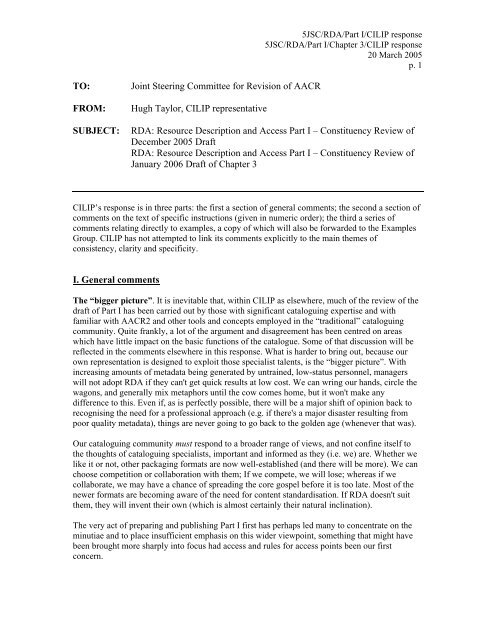

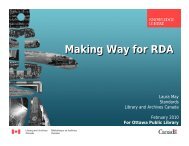
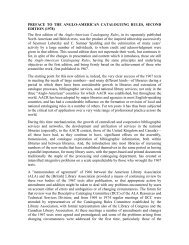
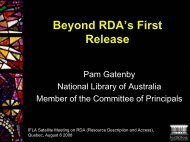



![Presentation slides [PDF] - Joint Steering Committee for ...](https://img.yumpu.com/41621230/1/190x143/presentation-slides-pdf-joint-steering-committee-for-.jpg?quality=85)

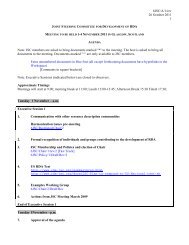
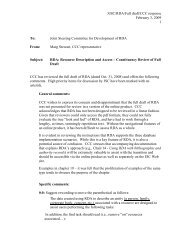
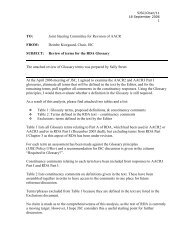
![Presentation slides [PDF] - Joint Steering Committee for ...](https://img.yumpu.com/35256207/1/190x143/presentation-slides-pdf-joint-steering-committee-for-.jpg?quality=85)
